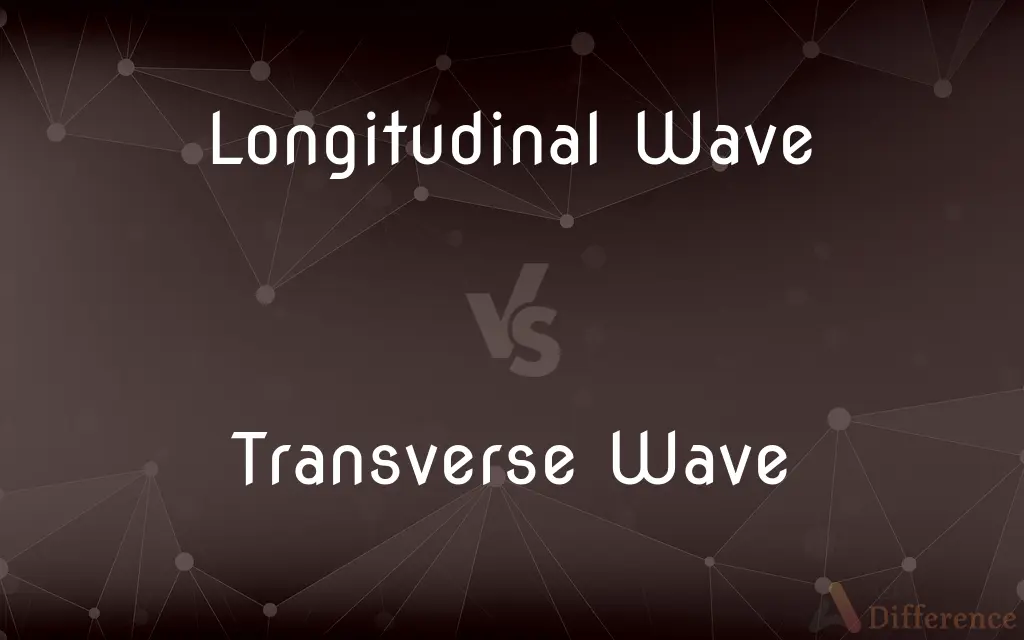Longitudinal Wave vs. Transverse Wave — What's the Difference?
By Fiza Rafique & Urooj Arif — Published on November 7, 2024
Longitudinal waves oscillate parallel to the direction of energy transfer, e.g., sound waves, while transverse waves oscillate perpendicular, e.g., light waves.

Difference Between Longitudinal Wave and Transverse Wave
Table of Contents
ADVERTISEMENT
Key Differences
Longitudinal waves, such as sound waves, involve oscillations in the same direction as the wave travels. This results in areas of compression and rarefaction in the medium. Transverse waves, like light waves, oscillate perpendicular to the direction of wave travel, creating peaks and troughs as they propagate.
In a longitudinal wave, the particle displacement is parallel to the direction of wave propagation, which is why sound waves can travel through gases and liquids where particles can easily compress and rarefy. Transverse waves require a medium that can support shear stress, making them more common in solids, though they also travel through vacuums as electromagnetic waves.
The speed of longitudinal waves depends on the density and the compressibility of the medium. In contrast, the speed of transverse waves is influenced by the medium's rigidity (for mechanical waves) or is constant for electromagnetic waves in a vacuum.
Detection of longitudinal waves often involves changes in pressure or density of the medium. For transverse waves, detection is typically based on changes in the orientation of the oscillating field or displacement.
Energy in longitudinal waves is transmitted through the compression and rarefaction of the medium, while in transverse waves, energy is transmitted through the motion of the medium at right angles to the direction of the wave.
ADVERTISEMENT
Comparison Chart
Oscillation Direction
Parallel to wave propagation
Perpendicular to wave propagation
Medium
Can travel through solids, liquids, and gases
Primarily in solids and vacuums (for electromagnetic waves)
Examples
Sound waves, P-waves (seismic waves)
Light waves, water waves, S-waves (seismic waves)
Speed Dependency
Depends on density and compressibility of the medium
Depends on medium's rigidity or is constant in a vacuum for light
Detection
Changes in pressure or density
Orientation changes of the oscillating field or displacement
Compare with Definitions
Longitudinal Wave
Detected by changes in medium pressure.
Microphones detect sound by measuring pressure variations from longitudinal waves.
Transverse Wave
Characterized by peaks and troughs in the medium.
Ripples on water surface are visible transverse waves.
Longitudinal Wave
Propagates through compression and rarefaction of the medium.
Ultrasonic waves, used in medical imaging, are longitudinal.
Transverse Wave
Speed is influenced by medium's rigidity or is constant for electromagnetic waves.
The speed of light in vacuum is a constant, demonstrating transverse wave properties.
Longitudinal Wave
Speed varies with the medium's properties.
The speed of sound, a longitudinal wave, increases in denser materials.
Transverse Wave
Requires a medium capable of sustaining shear stress or can travel through a vacuum.
Electromagnetic waves, including light, are transverse and can travel through space.
Longitudinal Wave
Can travel through various media, including gases and liquids.
Seismic P-waves, a type of longitudinal wave, can traverse the Earth's layers.
Transverse Wave
Detected by orientation changes in the oscillating field.
Polarized sunglasses block certain orientations of light waves, reducing glare.
Longitudinal Wave
A wave with oscillations in the same direction as its propagation.
Sound is a longitudinal wave that travels by compressing air.
Transverse Wave
A wave with oscillations perpendicular to its direction of propagation.
Light waves, oscillating electric and magnetic fields, are transverse.
Common Curiosities
Can longitudinal waves travel through a vacuum?
No, longitudinal waves require a material medium for their propagation and cannot travel through a vacuum.
What is the main difference between longitudinal and transverse waves?
Longitudinal waves oscillate parallel to their direction of travel, whereas transverse waves oscillate perpendicular to their direction of travel.
How do transverse waves travel through a vacuum?
Transverse waves like light can travel through a vacuum because they are electromagnetic waves, not requiring a physical medium.
Are water waves longitudinal or transverse?
Water waves are mostly considered transverse due to the up and down motion of the water surface, but they also have longitudinal components.
Why can sound not be classified as a transverse wave?
Sound is a pressure wave that requires a medium to compress and rarefy; it cannot create shear stress perpendicular to its direction, making it a longitudinal wave.
What factors affect the speed of transverse waves?
For mechanical transverse waves, the medium's rigidity affects their speed; for electromagnetic waves, speed is constant in a vacuum.
Can both wave types carry energy?
Yes, both longitudinal and transverse waves transmit energy through their propagation.
How is the speed of longitudinal waves determined?
The speed of longitudinal waves depends on the medium's density and its ability to be compressed.
What are seismic P-waves and S-waves?
Seismic P-waves are longitudinal waves that compress and expand the earth, while S-waves are transverse waves that move the ground up and down or side to side.
How are transverse waves detected?
By observing changes in the orientation of oscillating fields or displacement.
What applications utilize the properties of longitudinal waves?
Medical ultrasound and seismic exploration use longitudinal waves for imaging and probing the Earth's interior, respectively.
How are longitudinal waves detected?
Through changes in pressure or density of the medium.
What makes electromagnetic waves unique in their propagation?
Electromagnetic waves are transverse and can propagate through a vacuum, unlike most mechanical waves.
Why do longitudinal waves travel faster in solids than in gases?
Solids have higher density and less compressibility, facilitating faster propagation of compressions and rarefactions.
How do polarized sunglasses relate to transverse waves?
They block specific orientations of light waves, demonstrating the perpendicular oscillation characteristic of transverse waves.
Share Your Discovery

Previous Comparison
Connection vs. Disconnection
Next Comparison
RAM vs. Hard DriveAuthor Spotlight
Written by
Fiza RafiqueFiza Rafique is a skilled content writer at AskDifference.com, where she meticulously refines and enhances written pieces. Drawing from her vast editorial expertise, Fiza ensures clarity, accuracy, and precision in every article. Passionate about language, she continually seeks to elevate the quality of content for readers worldwide.
Co-written by
Urooj ArifUrooj is a skilled content writer at Ask Difference, known for her exceptional ability to simplify complex topics into engaging and informative content. With a passion for research and a flair for clear, concise writing, she consistently delivers articles that resonate with our diverse audience.












































